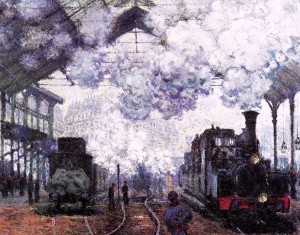SUNDAY, 7 NOVEMBER 2010
The latest of the weird and wonderful exhibits at the Tate Modern may not appear to have any connection to science. Neither may the masterpieces of Warhol, Dali, Picasso or Monet. But without scientific innovation, we would have had none of these. The 19th century saw the birth of modern science, with a surge of technological progress, revolutions in thinking and the founding of the scientific method. It is no coincidence that the same period saw the birth of modern art.Prior to the mid-1800s, art was used to produce realistic depictions of scenes. Subjects were almost always religious or mythical scenes, historical events or portraits of eminent people. Artwork was usually commissioned, and artists painted what their wealthy customers wanted. But within the last 150 years, modern science has changed the place of art in the world forever.
Photography is undoubtedly the technology that had the most obvious impact on art. By 1840, glass lenses, photosensitive silver compounds and fixing solutions had been combined to produce the first glass negatives. It was not long before photography was a cheaper and more accurate means than painting of producing realistic pictures of people, places and events. One of the purposes of art had been undermined.
 At a similar time, in 1851, The Great Exhibition at Crystal Palace was the first of many international expositions to bring the latest industrial and technological advances to the public. They created enthusiasm for machinery, industry and the future; it was a new world, a new technological era. With photography threatening the value of art and the public being swept away with science and technology, it would take a revolution to prevent art from being left behind.
At a similar time, in 1851, The Great Exhibition at Crystal Palace was the first of many international expositions to bring the latest industrial and technological advances to the public. They created enthusiasm for machinery, industry and the future; it was a new world, a new technological era. With photography threatening the value of art and the public being swept away with science and technology, it would take a revolution to prevent art from being left behind.The first step in this revolution was the emergence of Impressionism in the 1860s. The Impressionists, exemplified by Claude Monet, departed from conventional subject matter and – inspired by photography – captured moments from the new technologically-driven life: city street scenes, train stations, bridges and boats. But they did not set out to reproduce the scene accurately. Instead, they aimed to recreate the experience of a passing moment. The representation of the light was more important than the subject itself, a major departure from artistic convention and one which was triggered by the integration of technology into daily life. The Impressionists’ techniques were equally unconventional and also relied on recent scientific progress.
The use of colour in Impressionism was influenced by the colour theories of Michel Eugène Chevreul. As professor of chemistry at the Lycée Charlemagne, with expertise in dye compounds, Chevreul became director of the Gobelins tapestry works in Paris. During his time there, he noticed that the colour of a particular yarn appeared to change according to the colour it was immediately next to. He realised that this was due to an alteration in our perception of the first colour caused by the second, and published his theory of simultaneous contrast in 1839. The Impressionists incorporated his theories into their work to achieve the desired effects of light and shadow. Chevreul had discovered a perceptual oddity that forever changed the use of colour in art.
Also key to the Impressionists’ success were discoveries and new manufacturing techniques that changed their materials. Science was applied to the development of paints. New pigments based on the recently discovered elements of chromium, cadmium, zinc and cobalt provided brighter colours, while the manufacture of synthetic pigments added completely new colours.
More significant than the paints themselves was the collapsible paint tube. Before the 1840s, artists purchased pigments to grind and mix themselves and stored them in pigs’ bladders in their studios. But new manufacturing techniques allowed tin to be rolled thinly and pressed, leading to the invention of the squeezable tube by James G Rand in 1841. The tube was refined to incorporate a screw cap, allowing paint to be stored without drying.
The paint tube liberated the Impressionists and allowed them to work outside, since the paint was contained and easily transported; their choice of subject was unlimited. The new paints also contained paraffin wax and animal fat, resulting in a consistency that allowed thicker application. Because paints in tubes could be stored without drying, artists could afford a greater range of colours, and the new vibrant pigments helped them to recreate light effects. Pierre-Auguste Renoir, an eminent Impressionist, said that “without tubes of paint, there would have been no Impressionism”. And without Impressionism, there may have been none of what followed in the art world; the next generation of artists built on the revolution of the Impressionists and moved art forward with science.
By the early 20th century, science was changing the way people viewed the physical world, both literally and conceptually. Passenger steam trains were in common use and mass production of cars began in the early 1900s. Motorised transport carried people through their daily lives at speed; the world flashed by in flickers of light, familiar forms blurred together. Meanwhile, Einstein was changing the way we thought of space and time, raising new questions about the nature of the world and our experience of it. The impacts on art were profound.
No longer restricted by artistic conventions of subject and technique, the artists of the early 20th century explored this new world with radical approaches. Traditional perspective, form and colour were discarded entirely and rather than depicting scenes at all, paintings were used to convey concepts.
The Futurists attempted to represent the movement and dynamism of the modern world, rejecting every artistic convention and embracing the triumph of science and technology as their subject. Picasso and the Cubists explored the experience of seeing, and how our perceptions of objects are constructed from continually changing perspectives. They captured this by including multiple views of the subject in one picture. Their work developed to include no recognisable subject at all, but instead became metaphors for relativity and our visual experience of the world. Abstract art had been born.
The early 20th century also saw the first attempts to explain human behaviour scientifically. Sigmund Freud in particular was highly influential to the Surrealists. These artists, including Salvador Dali, created dream-like scenes with strange motifs, objects that merged into one another, and often sexual undertones in line with much of Freud’s work. They explored concepts of the mind, often turning to episodes or fears from their own lives for inspiration; this was completely new ground for art.
In the 1950s, the introduction of the television and expansion of print media and advertising – together with mass production of consumer goods – created popular culture; this then spawned ‘Pop Art’. Personified by Andy Warhol, pop art took mass produced symbols of popular culture and presented them as fine art. Mechanical techniques produced several identical pieces of artwork, challenging the concept of art itself.
In the modern digital era, art is still changing. Having provided an important trigger for the development of modern art, photography is now a major art form itself. Digital cameras and sophisticated editing software allow the creation of almost any visual effect. Combination of traditional materials and techniques with digital editing further widens the scope in art.
In a similar way to photography, the recent explosion in mass media and the internet may well have provided a new trigger for changes in art. They provide a continual bombardment of images, meaning that fine art can show us little new on a visual level. Instead, works such as Tracy Emmin’s My Bed, and Doris Salcedo’s Shibboleth (the crack in the floor of the Tate Modern) have come to the fore. This kind of conceptual art does not try to impress visually, but instead presents familiar images in unfamiliar ways, hoping to affect how we think.
The art of today is often scorned; it seems wacky, obscure and overpriced. But this could have been said of art at any stage of the last century-and-a-half. Looking back, we can see that modern art is an attempt to represent and understand a rapidly changing, technological world. Modern science has provided new material, both physically and conceptually, to drive a gradual progression of art that has brought us to the modern day. There is no doubt that future science will continue to drive the evolution of art.
Ian Fyfe is a PhD student in the Department of Pharmacology



